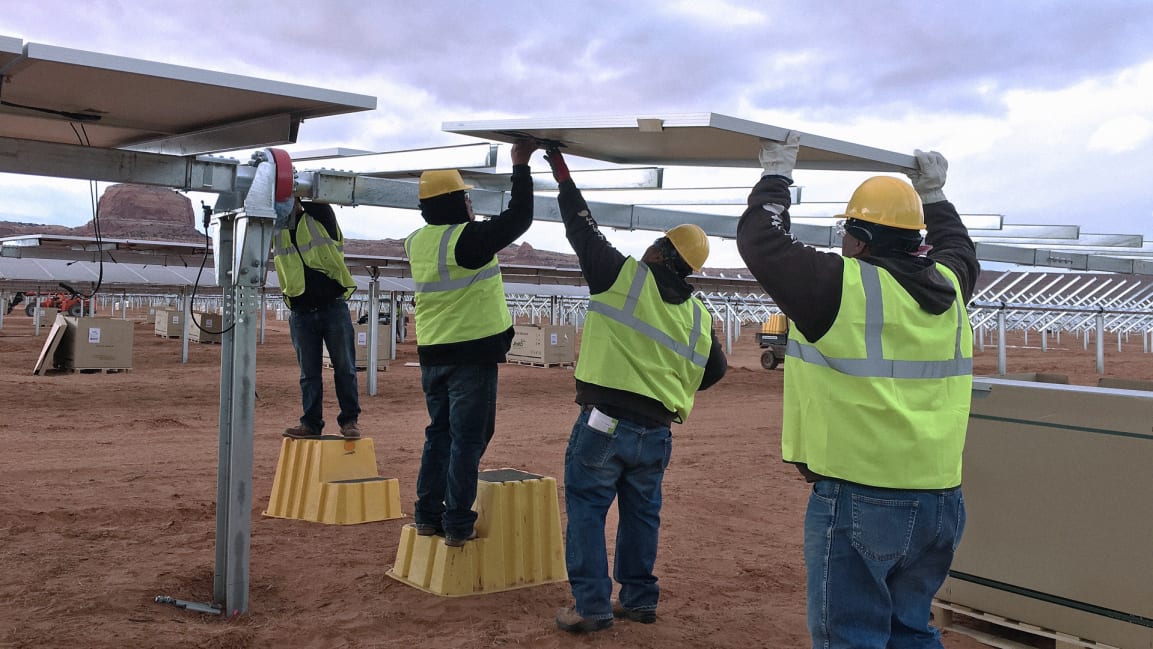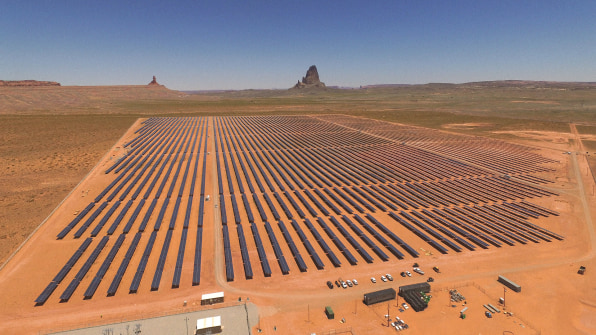Fast Company
Solar is starting to replace the largest coal plant in the western U.S.
On Navajo land in Arizona, a coal plant and coal mine that have devastated the environment are being replaced by solar–with both enormous benefits and local drawbacks that can serve as a lesson for how the rest of the country will need to manage the transition to renewables.
By Adele Peters May 30, 2018
 Photo: Navajo Tribal Utility Authority
Photo: Navajo Tribal Utility Authority
In the desert near Arizona’s border with Utah on the Navajo Nation, a massive solar array built in 2017 now provides power for around 18,000 Navajo homes. Nearby, construction will begin later this year on a second solar plant. And on another corner of Navajo land, the largest coal plant west of the Mississippi River is preparing to close 25 years ahead of schedule, despite some last-minute attempts to save it.
“Those two [solar] plants really are the beginning of an economic transition,” says Amanda Ormond, managing director of the Western Grid Group, an organization that promotes clean energy.
The coal plant, called the Navajo Generating Station, was built in the 1970s to provide power to growing populations in Southern California, Arizona, and Nevada. A nearby coal mine supplies the power plant with coal. As recently as 2014, the coal plant wasn’t expected to close until 2044–a date negotiated with the EPA to reduce air pollution. But reduced demand for coal, driven both by economics and climate action, means that the plant is scheduled to close in 2019 instead. The coal mine, run by Peabody Energy, will be forced to follow.
In 2016, Los Angeles, which owned a 21% share in the plant, completed a sale of its share to reduce city emissions. In 2017, the remaining owners announced that they would close the plant because coal power is no longer economically competitive. The plant’s largest customer, the Central Arizona Project, calculated that if it had purchased electricity from other sources in 2016, it could have saved $38.5 million.
 Photo: Navajo Tribal Utility Authority
Photo: Navajo Tribal Utility Authority
Though customers no longer want the coal, there’s some resistance to the early closure. Both the coal plant and the coal mine provide tribal revenue and jobs in an area where nearly half the population is unemployed. The coal plant owners are helping employees find new work, but some mine workers–along with Peabody Energy, which runs the coal mine on land that straddles the Navajo and Hopi reservations–are fighting to keep the plant open. The electric plant is the sole customer of the coal mine, so if the plant goes, so will the mine.
A lawsuit, filed by Peabody, coal miners, and the Hopi tribe, argues that the Central Arizona Project has to keep buying the coal under the terms of its contract as long as the plant is open–and efforts are being made to find a new buyer. (So far, the owners have shared information with some potential buyers, but haven’t received any offers.) An Arizona congressman drafted a bill that would exempt a new owner of the coal plant from some environmental regulations and force the Central Arizona Project to keep buying the power.
But while some living in the area want to try to keep coal going, others say that it makes more sense to shift to renewables. “There’s all this propaganda that’s been created saying that the Navajo are going to be devastated, the Hopis are going to be devastated,” says Percy Deal, a local activist. “We’ve already been devastated.” Deal, who is 68 years old, says that he has witnessed the destructive impact of the coal industry over its nearly 50-year history in the area.
The coal industry uses massive amounts of water in an area that has little of the resource. For decades–including a current long drought–the plant and mine have taken water from an aquifer that both the tribe and local wildlife rely on. (Another mine, which closed in 2005, used even more water as it pumped coal through pipes to Nevada.)
“Peabody can afford to drill deep wells . . . the people can’t afford to drill deep wells,” says Nicole Horseherder, another Navajo activist. “The people have been using springs and seeps for centuries, and the amount of water mining that Peabody does has an impact on the springs and seeps, and people’s ability to obtain and access water.”
Natural springs have run dry. Windmills that used to pull up water from an aquifer no longer can. Thousands of Navajo families still don’t have running water. Plants that were used in traditional food, medicine, and to dye rugs no longer grow in the area.
“Many of our wildlife–for example, deer, elk, antelope–these are all gone,” Deal says. “They have moved on to other areas simply because they cannot find these plants anymore. We also noticed that the bald eagles and other hawks have moved on. These are sacred animals to the Navajo and Hopi people.” Other animals, including a herd of wild horses discovered dead in early May, have died of dehydration.
The coal plant emits more greenhouse gas pollution than roughly 3 million cars, contributing to the changing climate that is, in turn, leading to both drought and heat waves in the area. The plant also emits thousands of tons of nitrogen oxide and sulfur dioxide pollution a year, which can cause lung disease, heart attacks, and strokes. Other pollutants from the plant, like lead, mercury, and manganese, can cause brain damage.
“When the plant and the mine close, for us that are living in the area, it’s a new beginning toward a healthier life,” Deal says.
Renewable energy can also bring new economic opportunity. When the coal plant owners decided to close in 2019, part of the agreement included turning over a 500-megawatt transmission line to Navajo tribal government. “We can see that having the transmission line is the greatest economic opportunity that the Navajo nation has ever had,” Deal says.
“It’s a great asset for the tribe, because they could either sell the rights of that transmission and make money, or they could develop their own projects . . . and use the transmission right to be able to sell pretty much to anybody in the western United States,” says Ormond. In addition to abundant sunshine, the Navajo reservation also has the best wind resources in Arizona, at Gray Mountain.
The first Kayenta solar farm, which started operating in April 2017, has 120,000 panels mounted on trackers that follow the sun to generate as much power as possible. It generates 27.3 megawatts of electricity, which is sold to Salt River Project, which also runs the coal plant. The power is sent across the reservation and to cities in Arizona, New Mexico, Utah, and California. At the height of construction, the project employed 284 people, the majority of whom were Navajo. The solar installation skills that workers gained can be used in the next solar plant, which will generate another 27.3 megawatts of power.
Nicole Horseherder argues that if the Navajo nation wants to stay in the energy business, it should invest in expanding its own solar power. “We’re saying, this way you’re producing it, you own it, you maintain it, you operate it, and you have so much more control over the revenue stream and the type of jobs that can be created,” Horseherder says.
If someone buys the coal plant to keep it running, Ormond says, that doesn’t guarantee that it will preserve good jobs. “The idea that someone can come in and run it more economically–the only way you’re going to do that is by cutting costs, and you’re not going to cut costs of operating the plant, you’re going to cut the cost of workers and pensions and coal,” she says. “So I just don’t see it happening.”
If more solar power provides electricity locally–in an area where many residents still don’t have power themselves–it could also make it possible to support different types of work. “You’ve got the basics for building a different economic future, because you’ve got lots of land, you’ve got sunshine, you’ve got power, you’ve got water,” says Ormond. And this could be possible, she says, without inflicting further harm. “Once you put up a solar plant, it just sits there and produces money and energy. It doesn’t use water, and it doesn’t degrade the landscape.”
About the author: Adele Peters is a staff writer at Fast Company who focuses on solutions to some of the world’s largest problems, from climate change to homelessness. Previously, she worked with GOOD, BioLite, and the Sustainable Products and Solutions program at UC Berkeley.
You Might Also Like:
The Energy Department Is Making Up Reasons Why You Need To Pay More For Dirty Energy
Can Puerto Rico Be The Model For A Renewables-Powered Energy System?
During Puerto Rico’s Blackout, Solar Microgrids Kept The Lights On
